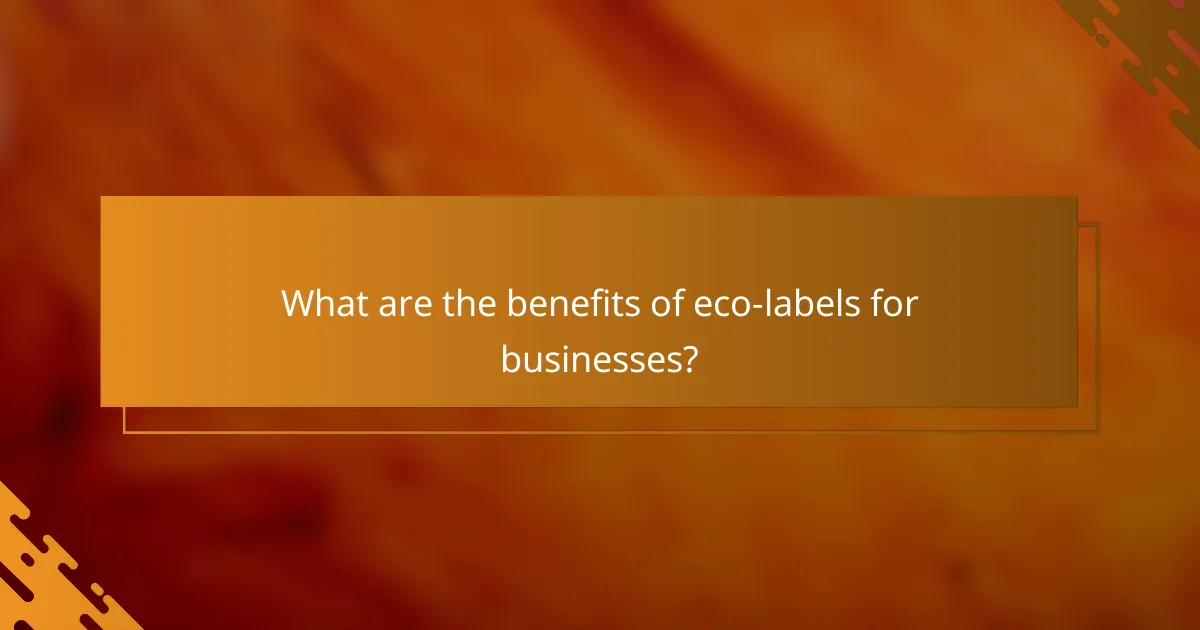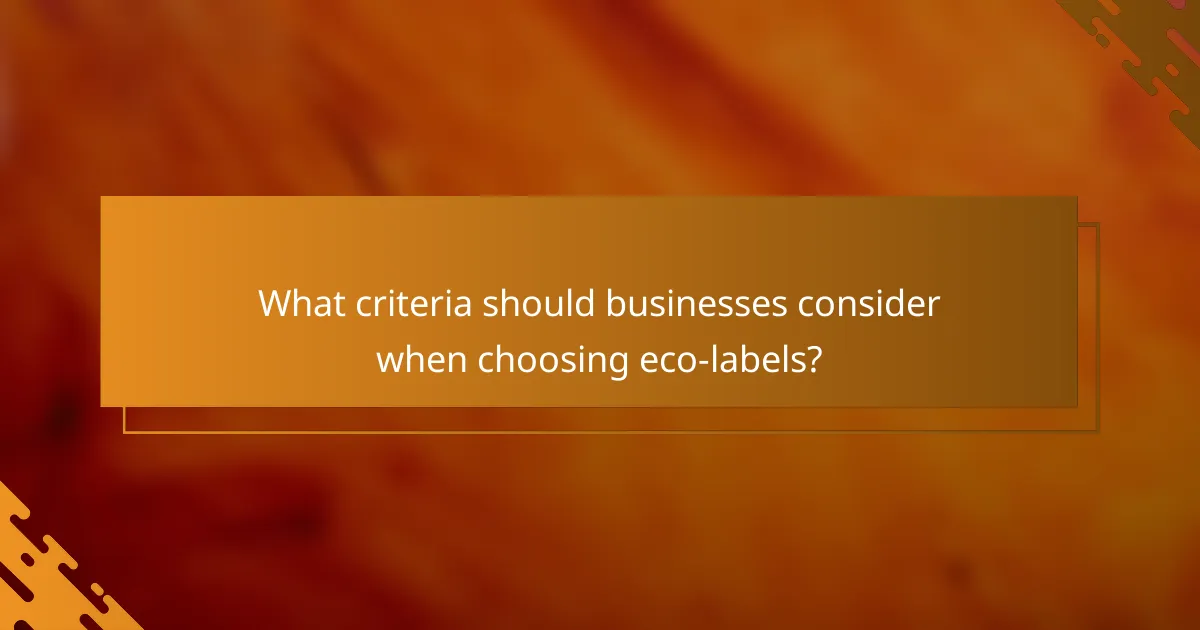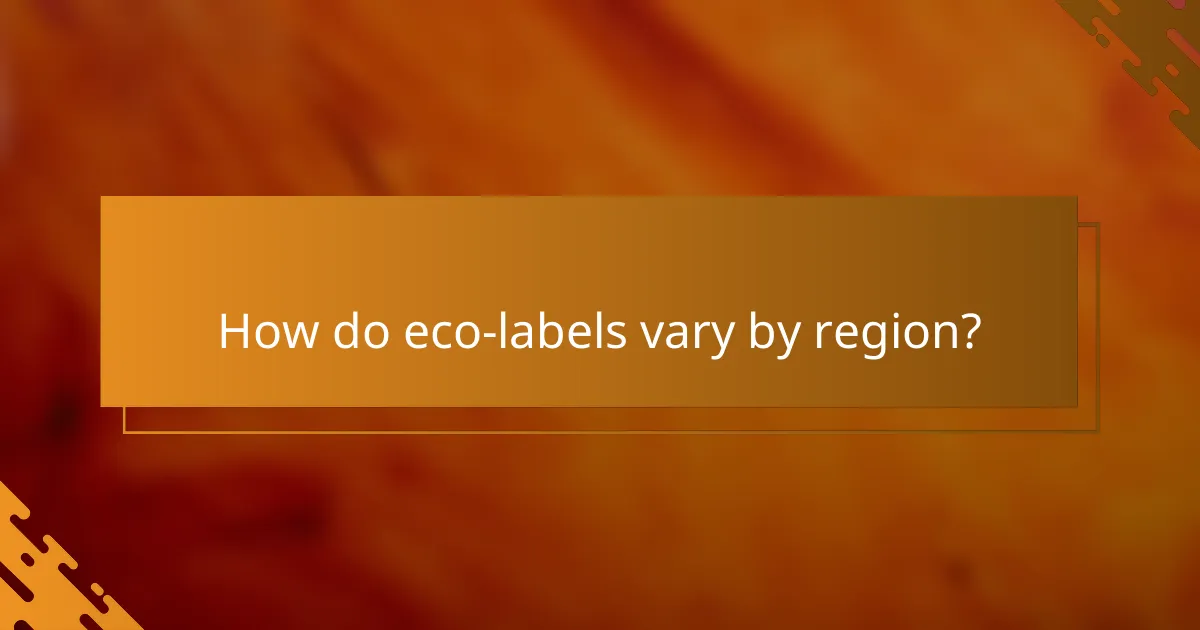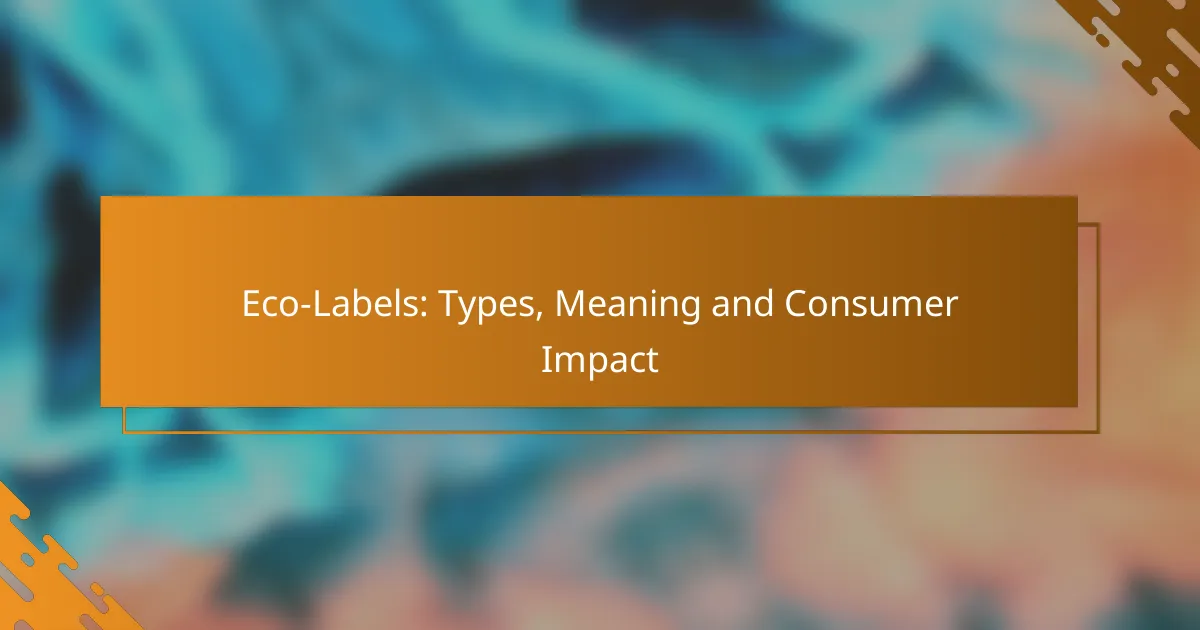Eco-labels are certifications that signify a product’s adherence to specific environmental standards, guiding consumers towards more sustainable choices. These labels not only enhance product credibility but also align with the growing consumer demand for environmentally responsible practices, influencing purchasing decisions significantly. By adopting eco-labels, businesses can showcase their commitment to sustainability, thereby attracting loyal customers who value eco-friendly options.

What are the different types of eco-labels?
Eco-labels are certifications that indicate products meet specific environmental standards. They help consumers make informed choices by highlighting sustainable practices in various industries.
Energy Star
Energy Star is a widely recognized label that identifies energy-efficient appliances and products. Items with this label typically use 10-50% less energy than standard models, leading to lower utility bills and reduced greenhouse gas emissions.
When shopping for appliances, look for the Energy Star label to ensure you are choosing energy-efficient options. This label applies to a range of products, including refrigerators, washing machines, and lighting fixtures.
Fair Trade
The Fair Trade label ensures that products are sourced from producers who receive fair wages and work under safe conditions. This certification is commonly found on coffee, chocolate, and handicrafts, promoting sustainable livelihoods for farmers and artisans.
When purchasing Fair Trade products, you support ethical practices and help combat poverty in developing countries. Look for the Fair Trade logo to ensure your purchase contributes to social and economic equity.
USDA Organic
The USDA Organic label signifies that agricultural products meet strict federal guidelines for organic farming. This includes no synthetic fertilizers, pesticides, or genetically modified organisms (GMOs), promoting environmental health and biodiversity.
Choosing USDA Organic products can help reduce exposure to harmful chemicals and support sustainable farming practices. This label is commonly found on fruits, vegetables, dairy, and meat products.
Forest Stewardship Council
The Forest Stewardship Council (FSC) label indicates that wood and paper products come from responsibly managed forests. This certification ensures that forestry practices are environmentally sound, socially beneficial, and economically viable.
When selecting wood products, look for the FSC label to ensure that your purchase supports sustainable forestry. This label applies to a variety of products, including furniture, paper, and building materials.
Cradle to Cradle Certified
The Cradle to Cradle Certified label assesses products based on their environmental and social performance throughout their lifecycle. This certification encourages the use of safe materials, renewable energy, and water stewardship.
Products with this label are designed for circularity, meaning they can be reused or recycled effectively. When considering purchases, look for the Cradle to Cradle Certified label to support innovative and sustainable product design.

How do eco-labels impact consumer purchasing decisions?
Eco-labels significantly influence consumer purchasing decisions by enhancing product credibility and aligning with environmental values. Shoppers often prefer products with eco-labels, believing they are more sustainable and trustworthy.
Increased trust in products
Eco-labels increase consumer trust by providing assurance that products meet specific environmental standards. When shoppers see a recognized eco-label, they often feel more confident in the product’s claims regarding sustainability and ethical practices.
For example, labels like Energy Star or USDA Organic are associated with rigorous testing and compliance, making consumers more likely to choose these products over non-labeled alternatives. This trust can lead to a preference for brands that consistently use eco-labels.
Higher willingness to pay
Consumers are generally willing to pay a premium for products with eco-labels, reflecting their commitment to sustainability. Research indicates that many shoppers may spend up to 10-20% more on eco-labeled items, viewing the extra cost as an investment in environmental health.
This willingness to pay can vary by product category; for instance, organic food items often see higher price premiums compared to non-food products. Understanding this trend can help businesses price their eco-labeled goods effectively.
Influence on brand loyalty
Eco-labels can foster brand loyalty by creating a connection between consumers and brands that prioritize sustainability. When customers identify with a brand’s environmental mission, they are more likely to return for repeat purchases.
Brands that consistently promote eco-friendly practices and maintain transparency about their eco-labels can cultivate a loyal customer base. This loyalty can translate into positive word-of-mouth and increased market share, particularly among environmentally conscious consumers.

What are the benefits of eco-labels for businesses?
Eco-labels provide businesses with a competitive edge by enhancing their sustainability credentials, which can lead to increased customer loyalty and market share. By adopting eco-labels, companies demonstrate their commitment to environmental responsibility, attracting consumers who prioritize sustainable practices.
Enhanced brand reputation
Eco-labels significantly boost a brand’s reputation by signaling to consumers that a company is dedicated to environmental stewardship. This commitment can foster trust and loyalty, as customers are more likely to support brands that align with their values.
For example, brands certified with well-known eco-labels, such as Energy Star or Fair Trade, often experience positive media coverage and customer engagement. This enhanced reputation can translate into higher sales and customer retention rates.
Access to eco-conscious markets
Businesses with eco-labels gain access to niche markets that prioritize sustainability, such as organic food or eco-friendly products. These markets can be lucrative, as consumers in these segments are often willing to pay a premium for environmentally friendly options.
In many regions, including the European Union, eco-labels can open doors to government contracts and partnerships that require sustainability certifications. This access can provide a significant advantage over competitors lacking such credentials.
Compliance with regulations
Obtaining eco-labels can help businesses comply with environmental regulations and standards, reducing the risk of legal issues. Many countries have implemented strict environmental laws, and eco-labels often align with these requirements, simplifying compliance processes.
For instance, in the EU, products with eco-labels may meet specific criteria that fulfill regulatory obligations, making it easier for businesses to navigate complex environmental legislation. This proactive approach can save time and resources in the long run.

How can consumers identify genuine eco-labels?
Consumers can identify genuine eco-labels by looking for certifications from recognized organizations and understanding the certification processes behind them. This ensures that the products they choose genuinely meet environmental standards and are not merely marketed as “green” without substantiation.
Understanding certification processes
Certification processes typically involve rigorous assessments that evaluate a product’s environmental impact. These assessments may include audits, testing, and compliance with specific standards set by recognized bodies. Familiarizing yourself with these processes can help you discern which labels are credible.
For example, a product certified under ISO 14024 is likely to have undergone a thorough evaluation, making it a more trustworthy eco-label. Look for labels that specify their certification process to ensure transparency.
Recognizing reputable organizations
Identifying reputable organizations that issue eco-labels is crucial for consumers. Well-known entities like the Forest Stewardship Council (FSC) or Energy Star have established credibility through consistent standards and rigorous evaluation processes. These organizations often provide detailed information about their criteria and certification methods.
Check if the organization is recognized by national or international regulatory bodies, as this can further validate its credibility. Avoid labels from obscure or unverified sources, as they may lack the necessary rigor.
Researching label claims
Researching label claims involves examining the specific criteria that a product must meet to earn its eco-label. Look for detailed descriptions of what the label signifies, including any environmental benefits or sustainability practices involved. This information is often available on the product’s packaging or the organization’s website.
Additionally, consider cross-referencing claims with independent reviews or databases that track eco-labels. This can help you verify the authenticity of the label and ensure that it aligns with your values regarding environmental sustainability.

What criteria should businesses consider when choosing eco-labels?
Businesses should evaluate eco-labels based on their market relevance, certification costs, and consumer awareness. These factors influence not only the credibility of the label but also its effectiveness in attracting environmentally conscious customers.
Market relevance
Market relevance refers to how well an eco-label aligns with consumer values and industry standards. Businesses should choose labels that resonate with their target audience, as this can significantly impact purchasing decisions. For instance, labels like Fair Trade or USDA Organic are widely recognized and trusted by consumers.
Additionally, consider the specific market segment. For example, eco-labels in the food industry may differ from those in textiles. Researching competitors and industry trends can help identify which labels are most effective in your niche.
Certification costs
Certification costs can vary widely depending on the eco-label and the complexity of the certification process. Businesses should assess both initial fees and ongoing costs, which may include annual renewals or compliance audits. For small businesses, these costs can be a significant investment.
It’s essential to weigh the potential benefits against these expenses. A well-recognized eco-label may justify higher costs by attracting more customers, while lesser-known labels might not provide the same return on investment.
Consumer awareness
Consumer awareness of eco-labels plays a crucial role in their effectiveness. If customers do not recognize or understand a label, it may not influence their purchasing choices. Businesses should consider labels that have strong brand recognition and clear messaging about their environmental benefits.
Engaging in marketing efforts that educate consumers about the meaning and importance of the chosen eco-label can enhance its impact. This could include in-store signage, online content, or social media campaigns that highlight the label’s significance and the company’s commitment to sustainability.

How do eco-labels vary by region?
Eco-labels differ significantly across regions, reflecting local environmental concerns, regulations, and consumer preferences. These labels help consumers identify products that meet specific sustainability criteria, which can vary widely from one country to another.
North America
In North America, eco-labels often focus on energy efficiency and sustainable sourcing. For example, the Energy Star label indicates that a product meets energy efficiency guidelines set by the U.S. Environmental Protection Agency. Consumers in this region tend to prioritize labels that highlight reduced energy consumption and lower greenhouse gas emissions.
Europe
European eco-labels, such as the EU Ecolabel, cover a broader range of environmental impacts, including resource use and waste management. These labels are regulated by the European Union and aim to promote products that have a reduced environmental footprint throughout their lifecycle. European consumers often look for comprehensive sustainability certifications that address multiple environmental aspects.
Asia
In Asia, eco-labels can vary greatly by country, with some regions emphasizing local environmental issues. For instance, Japan has the Eco Mark, which certifies products based on their environmental impact and recyclability. Consumers in Asia may prioritize labels that resonate with local sustainability challenges, such as pollution and resource depletion.
Latin America
Latin American eco-labels often focus on sustainable agriculture and biodiversity conservation. The Rainforest Alliance Certified label, for example, promotes products that support sustainable farming practices. Consumers in this region may be particularly interested in labels that ensure ethical sourcing and support local communities.
Africa
In Africa, eco-labels are emerging as tools to promote sustainable development and conservation. Labels like the Fair Trade certification highlight social and environmental criteria, aiming to support local economies. African consumers are increasingly seeking out products that contribute to both environmental sustainability and social equity.



